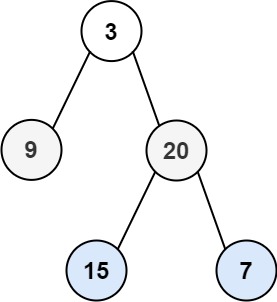Given the
rootof a binary tree, return the zigzag level order traversal of its nodes' values. (i.e., from left to right, then right to left for the next level and alternate between).
Example 1:
Input: root = [3,9,20,null,null,15,7] Output: [[3],[20,9],[15,7]]Example 2:
Input: root = [1] Output: [[1]]Example 3:
Input: root = [] Output: []
Constraints:
- The number of nodes in the tree is in the range
[0, 2000]. -100 <= Node.val <= 100
这道题面试的时候,要说。 有2种思路。 dfs 或者bfs
如果bfs的话,就是每层打印。 那么有2种方法, 递归 或者 迭代。
---------------------3rd pass-------- DFS ---------------
public class Solution {
public List<List<Integer>> zigzagLevelOrder(TreeNode root) {
List<List<Integer>> all = new ArrayList<List<Integer>>();
int height = getHeight(root);
for(int i =0;i<height;i++){
all.add(new ArrayList<Integer>());
}
dfs(all,root,0);
return all;
}
private void dfs(List<List<Integer>> all, TreeNode root, int level){
if(root == null)
return;
if(level %2==0){
all.get(level).add(root.val);
}else{
all.get(level).add(0,root.val);
}
dfs(all,root.left,level+1);
dfs(all,root.right,level+1);
}
private int getHeight(TreeNode root){
if(root == null)
return 0;
else
return 1+Math.max(getHeight(root.left),getHeight(root.right));
}
}
--------------------------1 st pass-----------------------
就是把 “Binary Tree Level Order Traversal ” 问题里的一句
普通的 level order traversal,只不过每层的时候,按照flag,加入结果的位置不同 而已
/**
* Definition for a binary tree node.
* struct TreeNode {
* int val;
* TreeNode *left;
* TreeNode *right;
* TreeNode() : val(0), left(nullptr), right(nullptr) {}
* TreeNode(int x) : val(x), left(nullptr), right(nullptr) {}
* TreeNode(int x, TreeNode *left, TreeNode *right) : val(x), left(left),
* right(right) {}
* };
*/
class Solution {
public:
vector<vector<int>> zigzagLevelOrder(TreeNode* root) {
bool l2r = true;
vector<vector<int>> res;
stack<TreeNode*> S;
if (root)
S.push(root);
while (!S.empty()) {
stack<TreeNode*> newS;
vector<int> curLine;
while (!S.empty()) {
auto tmp = S.top();
S.pop();
curLine.push_back(tmp->val);
if (l2r) {
if (tmp->left)
newS.push(tmp->left);
if (tmp->right)
newS.push(tmp->right);
} else {
if (tmp->right)
newS.push(tmp->right);
if (tmp->left)
newS.push(tmp->left);
}
}
l2r = !l2r;
S = newS;
res.push_back(curLine);
}
return res;
}
};

No comments:
Post a Comment